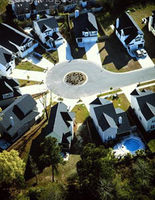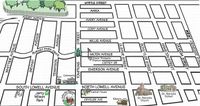Cul-de-sac
Cul-de-sac comes from a French word that literally means butt sack, a technical term associated with colostomy. Happily, the innovative Americans have moved it beyond its original medical meaning, and apply it to any street, lane, boulevard or terrace which does not carry any through traffic, meaning that only the people who live on it ever need to drive on it; and anyone who looks like he doesn't belong there certainly doesn't, and can be hauled off without time-consuming discussions of rights.
Cul-de-sacs are populated by parents who moved there so their children would not get run over by a car — and children who try hard to hurt themselves on skateboards, pogo sticks, and no-hands bicycles to compensate. Though the family moved to the cul-de-sac to keep from having to dodge interstate highway traffic and stray bullets from drive-by shootings, the result is always intense boredom.
History[edit | edit source]
The typical neighborhoods of the 1950s and 1960s had streets in a grid, patterned after the Romans and perfected in the inner-city areas of Philadelphia and Detroit. It was reassuring, in those simple days, to know that even though you were inadvertently on a side street, you could keep driving in the same direction and get somewhere (albeit late).
In later decades, again following the lead of Philadelphia and Detroit, residents decided they didn't want anyone they don't know being on their street, even if he claimed to be "headed somewhere else." Developers began designing curvy streets, squiggly streets, and dead-end streets, which evolved into the modern cul-de-sac.
In the old days, automobiles were not as lethal as they are today, and it was inexpensive to have children — so much so that families of five to ten children were common, and it didn't matter if a few were knocked off by speeding traffic. The fallen could be easily replaced with a fresh batch. These trends, too, have reversed. Cul-de-sac residents, if they have children at all, have a small number of them, and simply wrap them in bubble tape until the age of 27.
Kickball[edit | edit source]
Many cul-de-sacs end in a wide, disk-shaped asphalt playing field for children — the center of which sometimes contains grass or even a tree. This has led to yet another renaissance from the post-war years: a resurgence of the sport of kickball. The rock-hard ball meant that the game could not be played anywhere near a house's windows, but it is perfectly suited for play in a cul-de-sac, and modern rules take advantage of the circular playing field.
Depending on the size of the cul-de-sac, and the age of the kids, youngsters can often have a full summer of kickball, with little risk of property damage and only occasional game stoppages to let one of the three cars pass.
The trade-off for high-flying kickball action is a crippling drop in lemonade sales. Fewer cars also means less business for young entrepreneurs. Back in our day, teams could pay for their kickball uniforms with only a few weeks of selling lemonade at half-time. These days, young lemonade hucksters can barely recoup the cost of their lemons.
The ice-cream truck has been another casualty of the new interest in kickball. You'd think that more warm bodies in the street would help business, but kids don't bring their wallets to kickball and rarely run home to hit their parents up for cash (especially after the failed lemonade-stand investments). The real advertising of the ice-cream-truck is its 1920s Scott Joplin music, the call-to-prayer of the sweet tooth, that draws suckers in the home just as well as those in the cul-de-sac. Conversion of a neighborhood into twisty little passages and cul-de-sacs slows down the drivers it does not intimidate entirely. In many cities, the Good Humor man needs to also have a real job.
Famous residents of cul-de-sacs[edit | edit source]
Many famous people live in cul-de-sacs. We confine our study to the celebrities who live in cul-de-sacs for specific reasons.
- Dr. Phil McGraw: Lives in a cul-de-sac so that when he steps out on his porch to get the paper, he can scold the parenting methods of every neighbor on his street without having to turn his neck more than 35 degrees.
- Shaquille O'Neal: Moved to a cul-de-sac in Southern Florida because he is being brought in as a ringer for the Steinbrenner-owned kickball team, The Insane Turkeys. He has a petition out to get the official name of this street plan changed to "cul-de-Shaq," but so far no one has signed it.
- Ray Romano: Has lived in the cul-de-sac that originally inspired his middle-class-ploitation sitcom, Everybody Loves Raymond. He intends to stay in the Sac until his twin sons — who are a powerhouse duo on the kickball court — leave for college. In the meantime, he's encouraging them to pursue scholarships to NCAA Division II kickball powerhouses such as Winona State and Amherst.
- Regis Philbin: Reej is the nation's highest paid youth kickball coach in the country. His team, the Locust Lane Super-Shredders, has been neighborhood-wide intramural champs for 3 of the last 4 seasons. Says 6th grader Tom Whipkey, "If you think he's a handful on TV, you should see him on days when we're mis-timing our wind-ups. One summer he worked us so hard that we had to warm up for each practice by digging a huge hole in his backyard. I always thought it was odd that he never had us back to fill the hole up again, but when I asked him about it, he snapped, 'Your business is Kick Business! Now the next time you screw up your fundamentals during the semis, you'll find out what a good ol' hole in the ground is used for!'"
- Larry the Cable Guy: The Cable Guy has an admitted gambling problem. Sources say he once blew $700,000 betting on kickball, while bingeing on $2,000 of lemonade. But he refuses to move farther away from his temptations.
- John Grisham: Says that the quiet, relaxing atmosphere of his cul-de-sac helps him concentrate while he's writing books about men holding briefcases talking to other men with briefcases who are wearing dresses and holding a hammer.
- Sean (Piddle) Combs: Hasn't played much since 4th grade, but is getting back into kickball for the love of the game.
Always shaped like genitalia?[edit | edit source]
Cul-de-sacs are the one style of suburban street capable of resembling every type of genitalia, often simultaneously. Some states are considering relocating registered sex offenders to cul-de-sacs despite the resemblance to that which they have, uh, gotten in trouble for. Problems with this plan include finding general contractors willing to plan new neighborhoods featuring courts that deliberately imitate naughty bits, and yet able to stay focused when it is time for actual construction.
Mandrake Drive, in Danbury, Conn., definitely puts the lotion in the basket.





